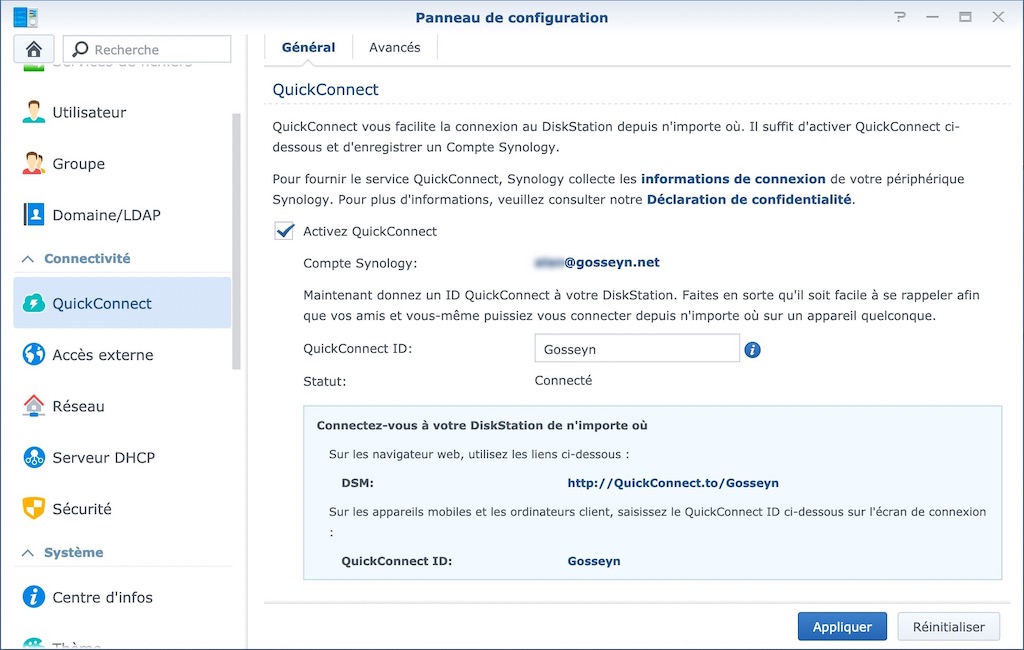

- Synology drive configuration how to#
- Synology drive configuration install#
- Synology drive configuration password#
Synology drive configuration how to#
Learn how to set up Nginx Proxy Manager on a Synology NAS using Docker! Full written instructions that guide you through the whole process! If you have any questions, please leave them in the comments! Related content Nginx Proxy Manager Synology NAS Setup Instructions! - WunderTech › It’s not normal that you need to set up two different Docker containers to get one container to work, but in my opinion, this is the best way to get Nginx Proxy Manager working on a Synology NAS. This was a fairly complex tutorial, but I am hoping that it’s broken down enough to be easily understood. The tutorial is fairly straight forward, but highlights how you can expose practically any web server quickly, easily, and securely! 4. Now that we set up Nginx Proxy Manager, it’s important to know how to use it! I created a tutorial that you can follow that will show you how to expose Plex and setup an SSL certificate. Keep the default docker bridge network interface connected to both containers and use that IP address in the config.json file. If your NAS has multiple NIC’s and you have multiple IP addresses assigned to it, in the “config.json” file, enter the other IP address of your NAS.Ģ. After troubleshooting this for a while (and a few helpful suggestions in the comments), there are really two ways to fix this:ġ. Nginx Proxy Manager is now set up! Ensure that you port forward ports 80 and 443 on your router to the macvlan network we created above.Ĭertain people are experiencing “bad gateway” errors when they try and login. When prompted, change your name and email address, then set up your password.ģ.
Synology drive configuration password#
Login with the email address and password changeme.Ģ. Nginx Proxy Manager Setup – Synology NASġ. Select Apply and create the container! Give the container a few minutes and you should be able to access the web admin portal through the npm_network IP address and port 81! 2. The IP address of the bridge I am creating will be 192.168.10.2.Ĩ. Select Add and enter a subnet that’s not currently in use. Open Docker and navigate to the Network section. This is what will allow our host (NAS) to communicate with our Nginx Proxy Manager container. Next, we need to create a bridge network. If you are disabling it and created a firewall rule for it, you should inactivate the firewall rule as well.Ħ. We can now exit our SSH session and disable it in DSM (if you won’t be using it). NOTE: npm_network will be the name of the network (you can substitute this as you’d like). You also need to pick an IP address that you’d like to use that’s not currently in use. Next, you need to run the command below while substituting the correct subnet (most are 192.168.1.0/24 or 192.168.0.0/24 by default). To do this, run the command below and note down the network interface name that has your Synology NAS’s IP address (in this example, mine is eth0). First, we need to determine what network interfaces currently exist (on your Synology NAS) and note down the adapter name. We need to create a Docker macvlan network interface. SSH into your Synology NAS using your favorite SSH tool.ģ. Ensure that you change SYNOLOGY_NAS_IP to the IP Address of your Synology NAS!Ģ. This file must contain the contents below. Create and upload a file named config.json to the nginx-proxy folder. Inside of the nginx-proxy folder, create two sub-folders named data and letsencrypt.Ĥ. Inside of this folder, we are going to create a folder named mariadb and nginx-proxy.ģ. By default, the Docker package will create a folder named docker after it’s finished installing. We need to create a few folders that we will be mapping our Docker containers.
Synology drive configuration install#
Install Docker from Synology’s Package Center.Ģ. For this reason, we will create a macvlan network interface (in Docker) that will allow us to bypass this port conflict.ġ. By default, Synology uses ports 80 and 443 so using our host network interface isn’t ideal. One for our database and one for Nginx Proxy Manager. Since Nginx Proxy Manager uses a database, we will need to install two different containers. This tutorial will utilize a Synology NAS and Docker. Setup Instructions – Nginx Proxy Manager Synology NAS


 0 kommentar(er)
0 kommentar(er)
